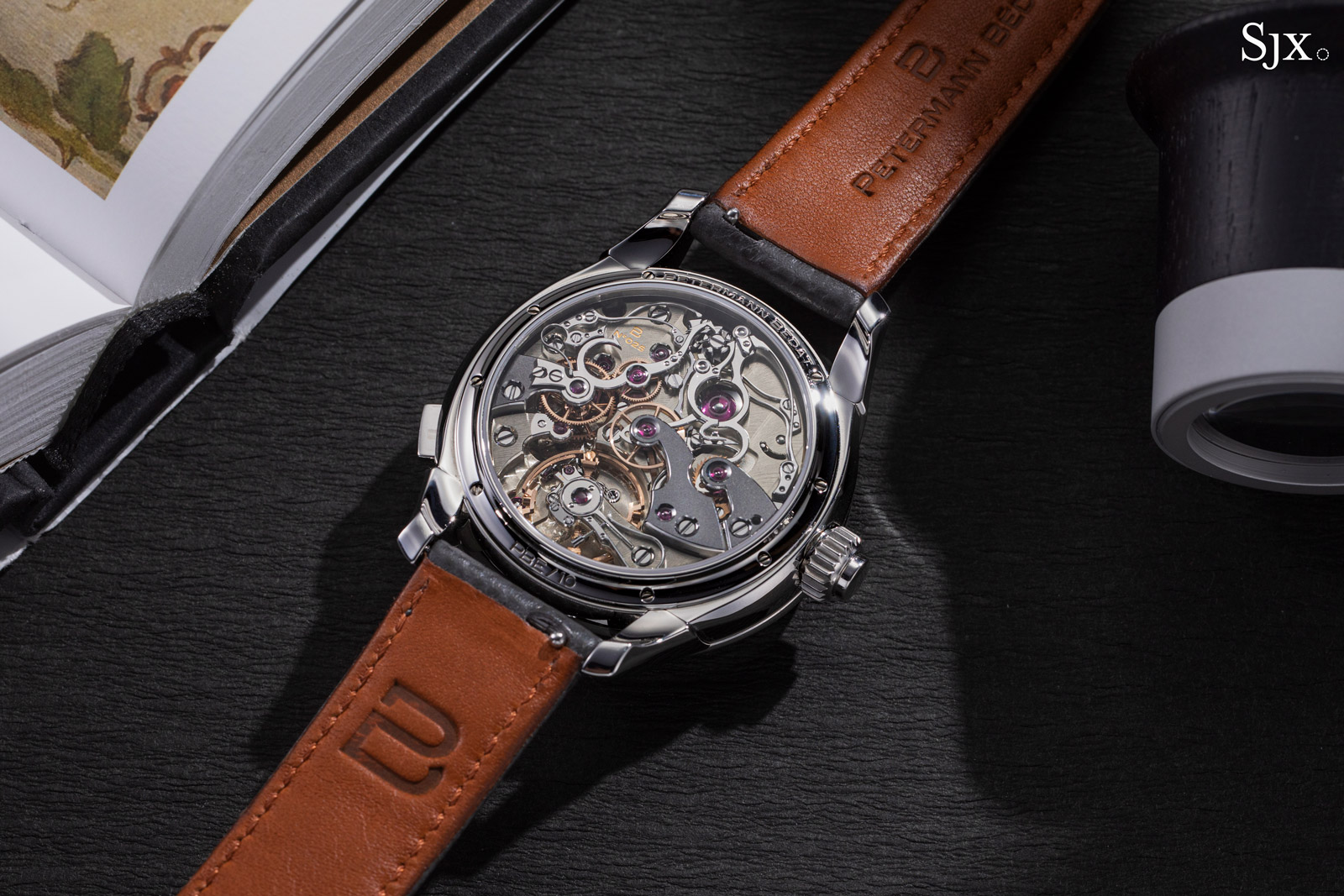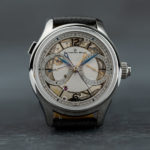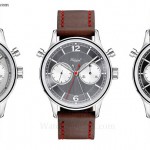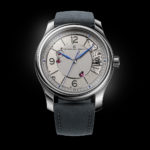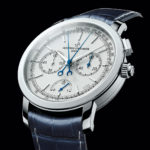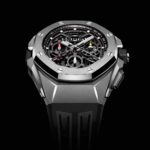In-Depth: Petermann Bédat Reference 2941 Split-Seconds Chronograph
Very good but...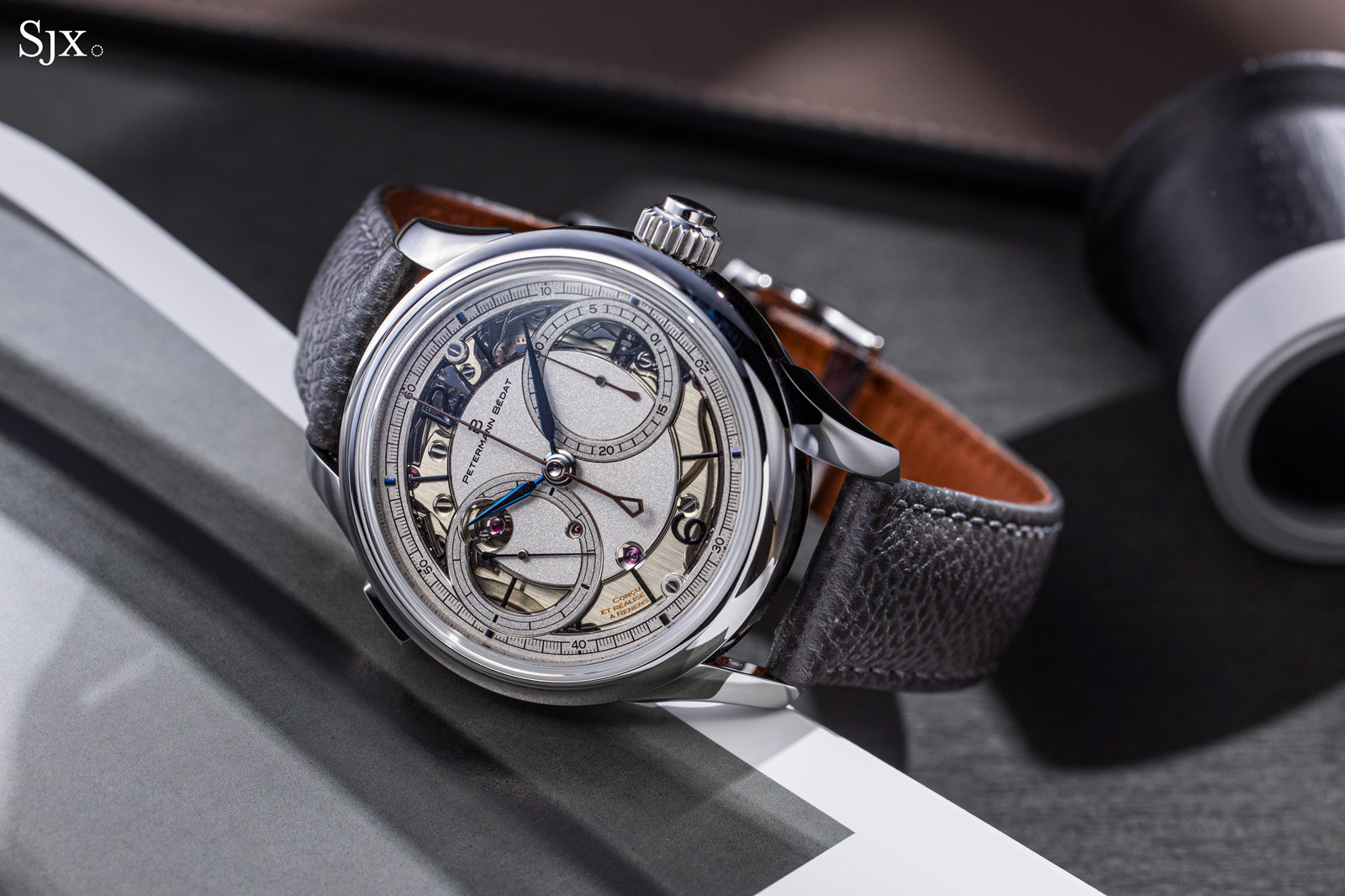
Having made its debut in 2020 with the 1967 deadbeat seconds, Petermann Bédat recently unveiled its second watch, the Reference 2941 Split-Seconds Chronograph. The 2941 lives up to the benchmark established by its predecessor with a traditionally-styled movement that is decorated to an impressive degree, albeit one that reflects constraints in its development.
The brand’s founders, Gaël Petermann and Florian Bédat, are both watchmakers in their early 30s who studied watchmaking in Geneva before a stint at A. Lange & Söhne. The pair also spent time carrying out restorations of vintage watches. Their shared experience is illustrated in the 2941, most notably in the traditional decoration and styling of the movement.
Initial thoughts
When Petermann Bédat made its debut in 2020 with the 1967, a time-only with deadbeat seconds, independent watchmaking was a much less crowded space. As a result, the 1967 stood out for both its intrinsic qualities, namely excellent finishing and traditional mechanics, but also the fact that it was fairly novel. Now time-only watches with seemingly good finishing seem to be everywhere, most of which are even similar to the Petermann Bédat profile in having founders in the their 30s and 40s.
So Petermann Bédat did well in introducing a following up with something more complicated for its second model. The 2941 continues with the aesthetics of the 1967, essentially a modernised “sector” dial, and also the movement finishing. The quality of movement decoration is self evident. Not only is every component finished to a high level, the movement was evidently designed to be decorated and to show off that very decoration.
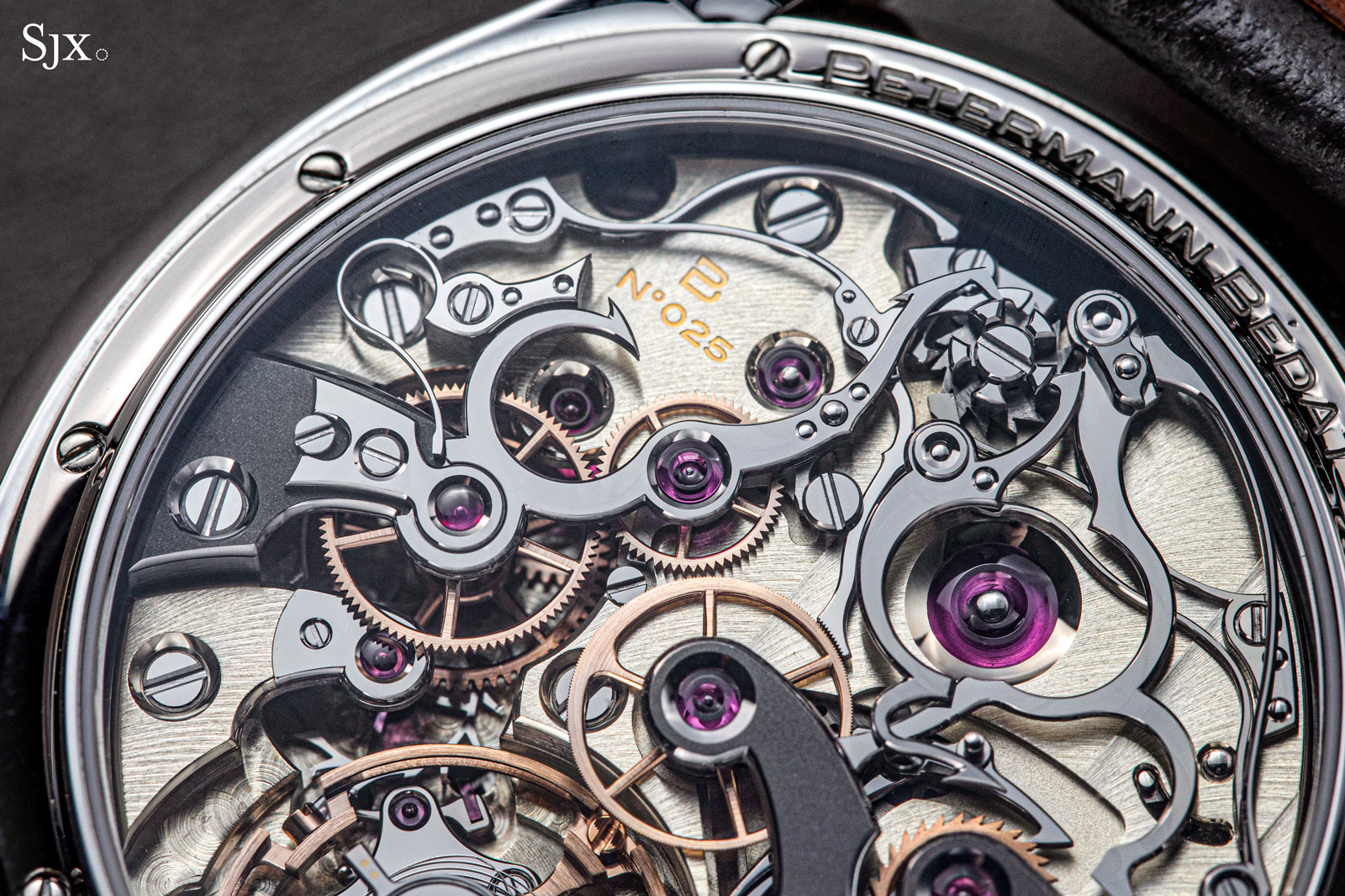
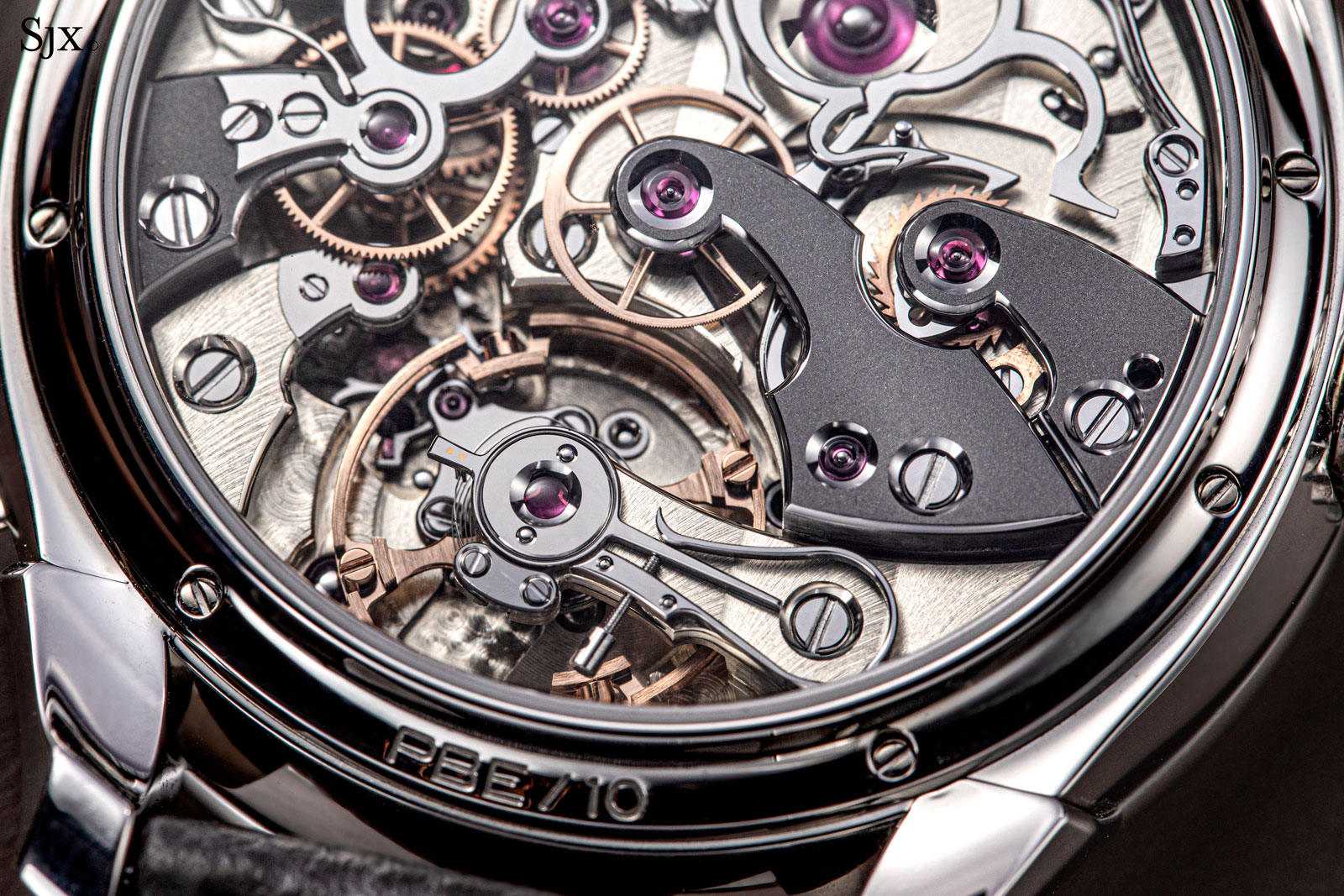
Notably, the dial is also executed to a high level and is almost certainly one of the most expensive aspects of the watch. Because of the material and techniques required – platinum, sapphire, and adhesive – it was produced by Comblémine rather than in-house. And the dial maker definitely charged Petermann Bédat a substantial sum for the dials, I am guessing the low five figures, particularly since the number required was small.
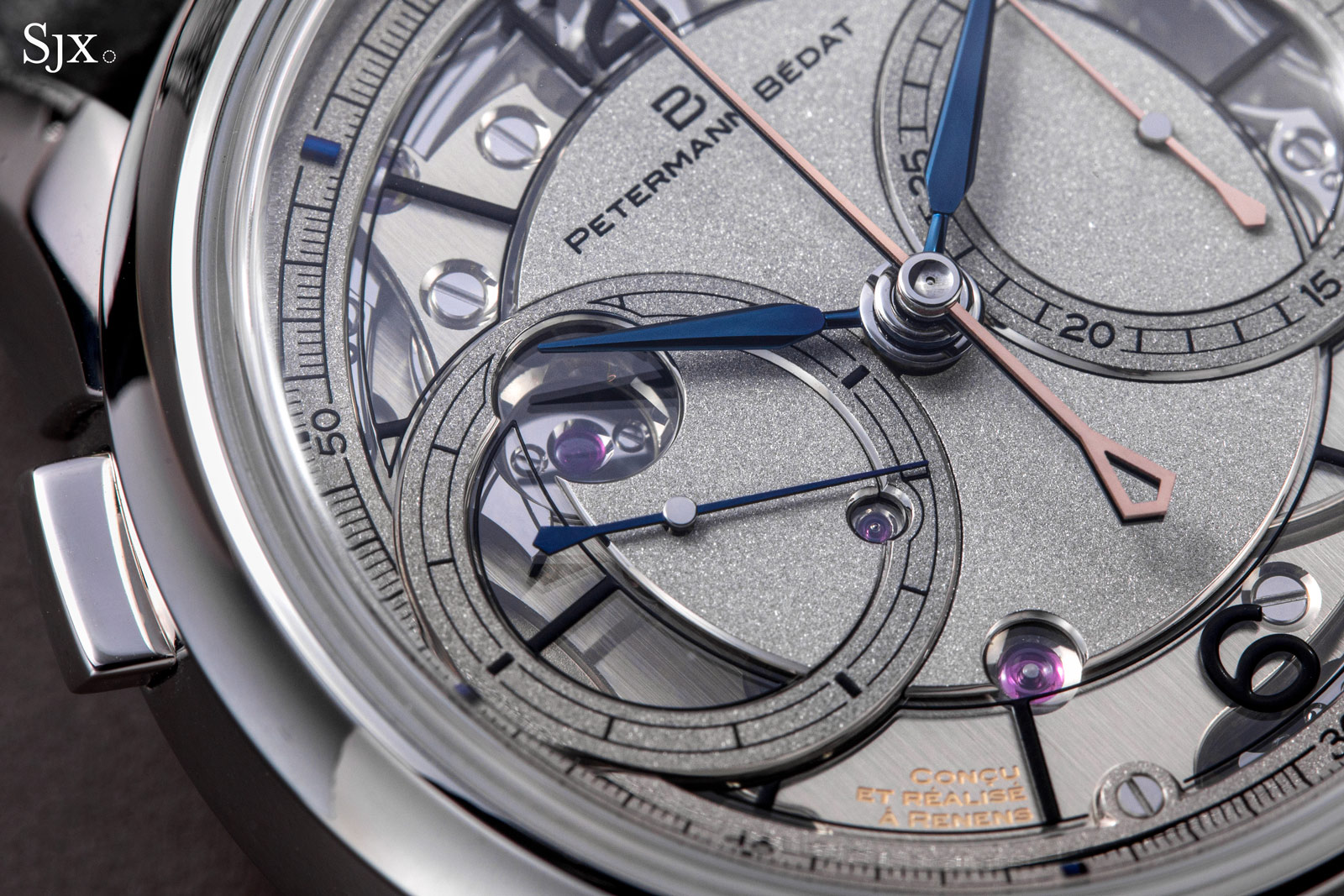
However, the 2941 does have a few shortcomings considering its CHF243,000 price, which is equivalent to about US$280,000. For one, the movement is a mix of old and new. The chronograph mechanism is original – and unquestionably beautiful – but it is constructed on top of a base movement that’s the same one found in the 1967, but with modifications to the going-train layout to accommodate the chronograph. That base movement in turn is based on the Valjoux 13”’, a venerable design that spawned the Valjoux 23, 72, and assorted other well-known calibres used by a variety of brands throughout the 20th century.
The other shortcoming is the dial-side rattrapante mechanism that Petermann Bédat chose for two reasons. One being reliability – the Valjoux 13”’ was not originally a split-second – perhaps implying that an add-on split-seconds mechanism on the back might be finicky (though Patek Philippe did it in the past in the ref. 1436). The second is the fact that the sapphire dial shows off the split-seconds mechanism.
However, high-end split-seconds chronographs almost always have the rattrapante mechanism on the back. This is more complex to implement due to the resulting height of the co-axial seconds hand pinions that have to extend beyond the height of the movement, but infinitely more appealing visually as the split-seconds mechanism can be admired through the display back. Again, this price tag should come with a traditional split-seconds.
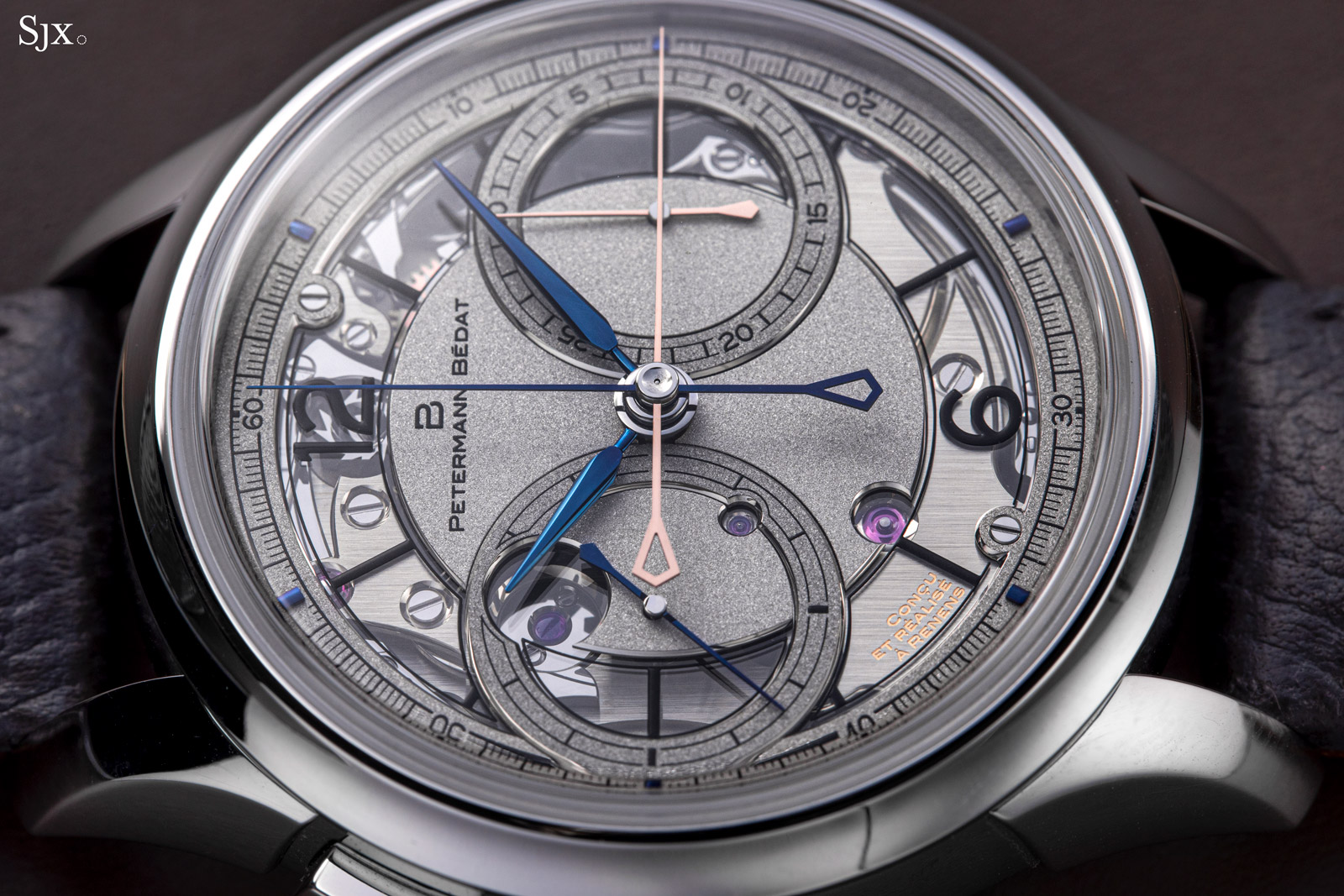
In Petermann Bédat’s defence, however, the 2941 is arguably entirely justified when considering the economics of the watch, which created constraints that Petermann Bédat handled well. As a limited edition of only 10 watches, the 2941 lacks economies of scale. The dial, for example, was clearly expensive, as was the development of the split-seconds mechanism.
Even accounting for Petermann Bédat releasing a simple chronograph based on the same movement – it has not been announced but that’s a given – the small output of the brand means it won’t have the volume to make an original base movement feasible. As things stand, the 2941 is as good as it gets considering the development constraints.
But evaluating the 2941 purely on its intrinsic qualities, the verdict: good but too expensive. That is even the case when compared against the Lange Triple Split, one of the most sophisticated modern chronographs but already expensive at US$174,600. Even then the 2941 costs almost US$100,000 extra.
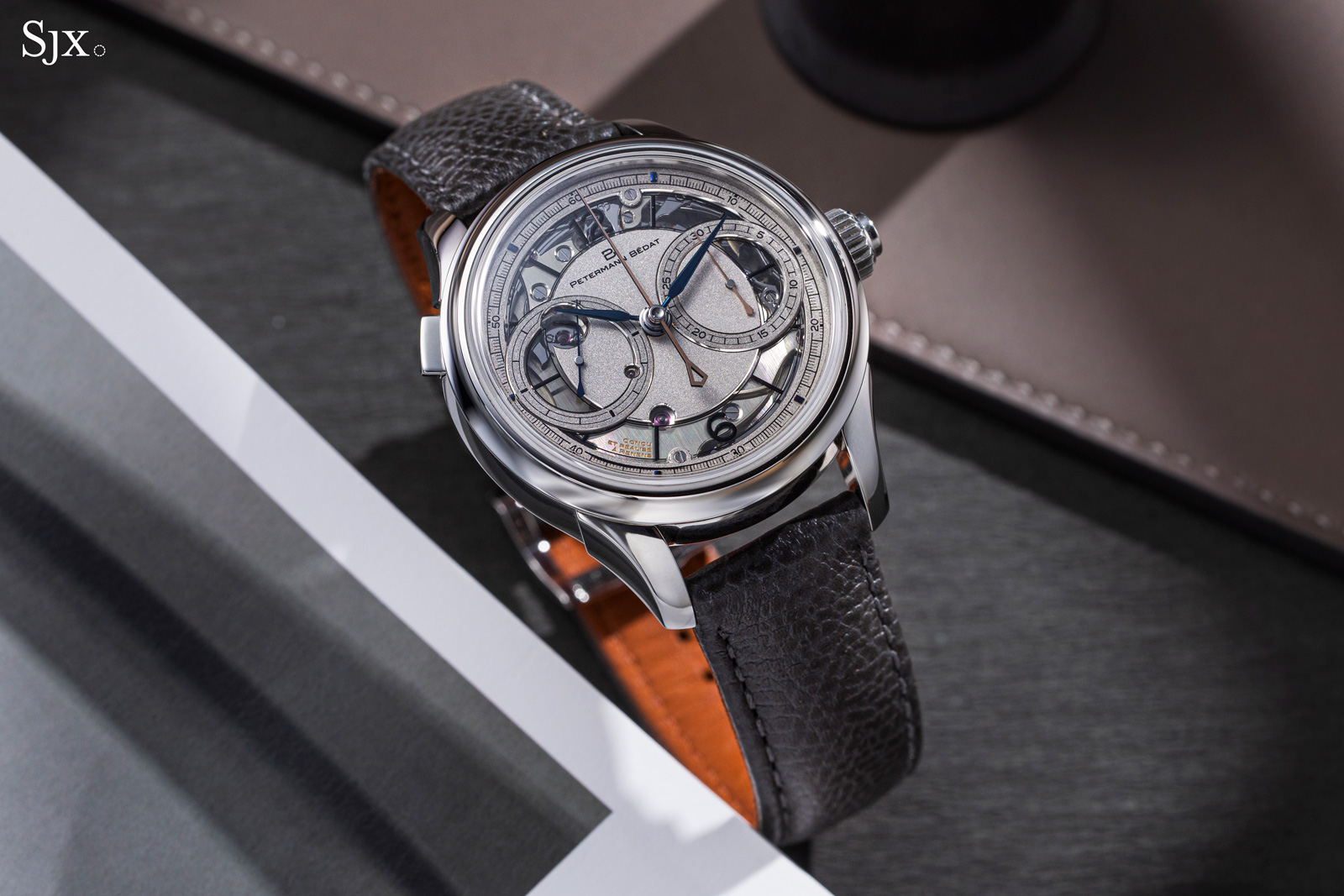
A classical chronograph
The cal. 202 inside the 2941 split-seconds chronograph is beautiful in both construction and details, largely because it has all of the elements that make a chronograph movement attractive, even to an exaggerated degree. These include the slender, gracefully curved steel levers and sharply angled bevelling on the chronograph bridges.
The architecture clearly borrows from both Lange and Minerva, both brands that excel at traditionally styled chronograph movements. But it has enough original elements, like the oversized jewels and wide chronograph bridges, so that it doesn’t feel derivative.
Besides the styling, two features of the cal. 202 stand out. One is the mono-pusher construction that condenses the chronograph buttons into just two, one disguised as part of the crown and the other at 10 o’clock, giving the watch a clean, elegant profile. The other is the jumping minute counter, no doubt borrowed from the Lange Datograph, a minor complication that nonetheless adds a bit more sophistication to the chronograph.
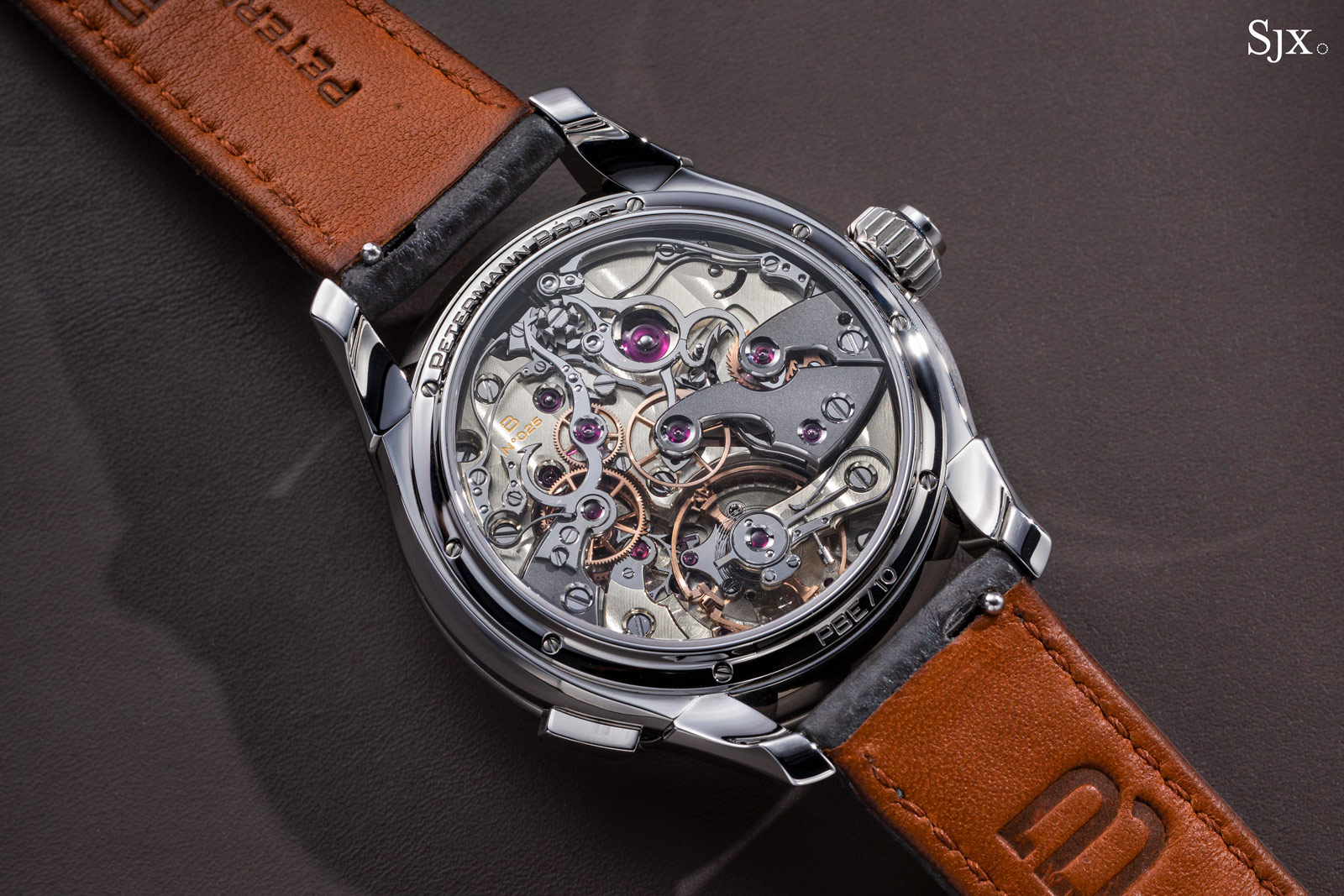
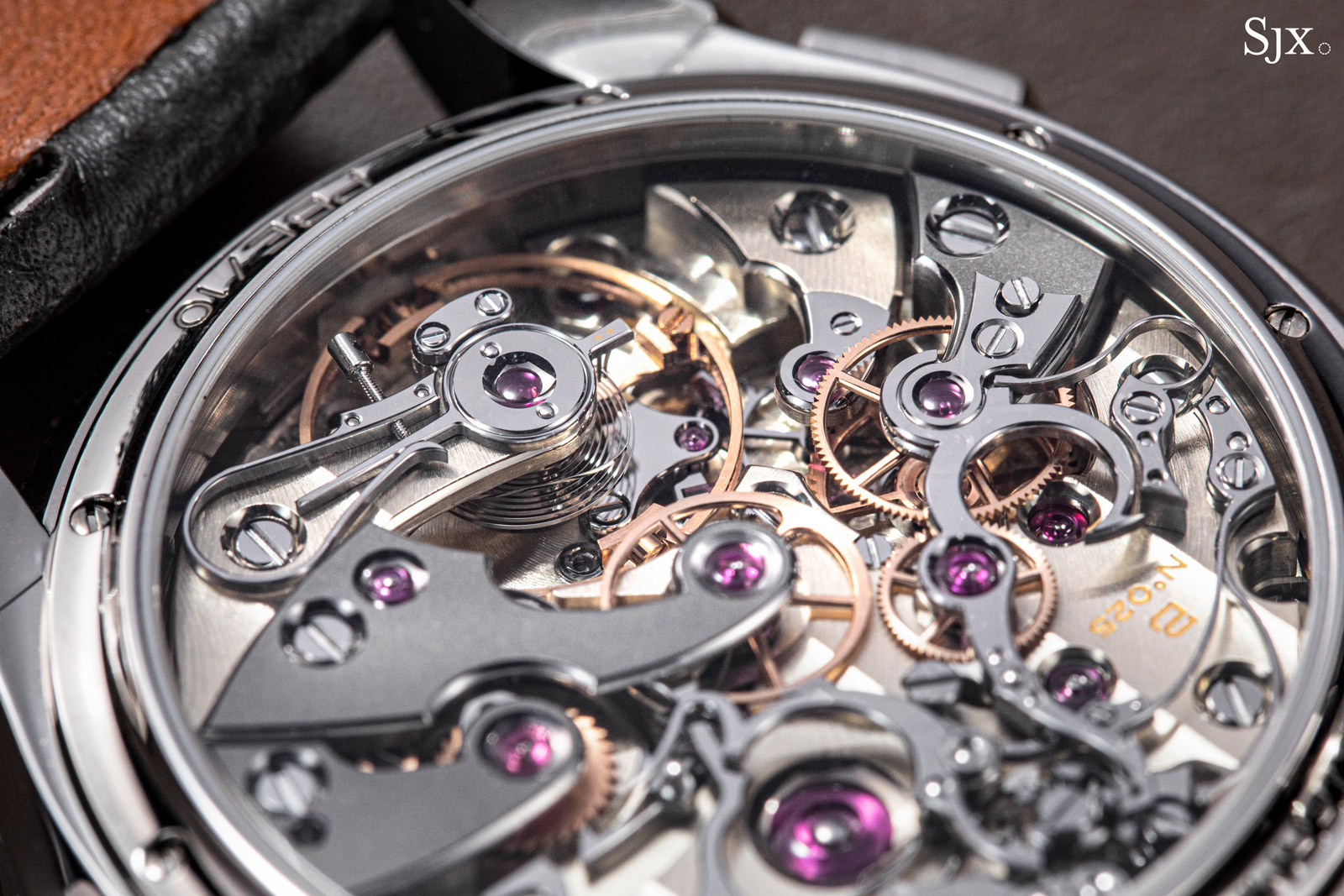
Despite not having the split-seconds mechanism on the back, the movement has depth thanks to the narrow levers and springs of the chronograph works
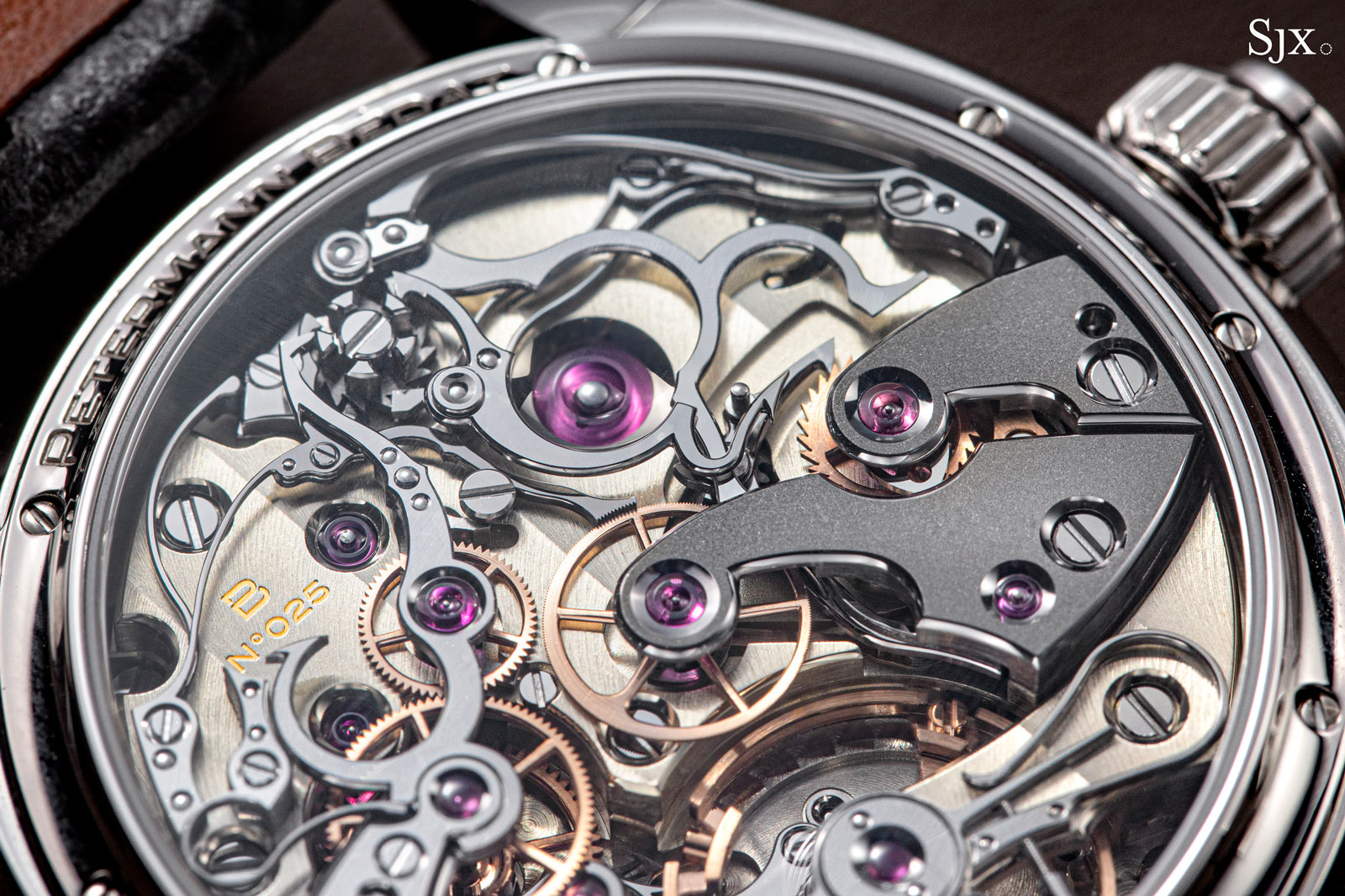
The decorative half-arrowheads at the ends of several levers are clearly inspired by Minerva movements
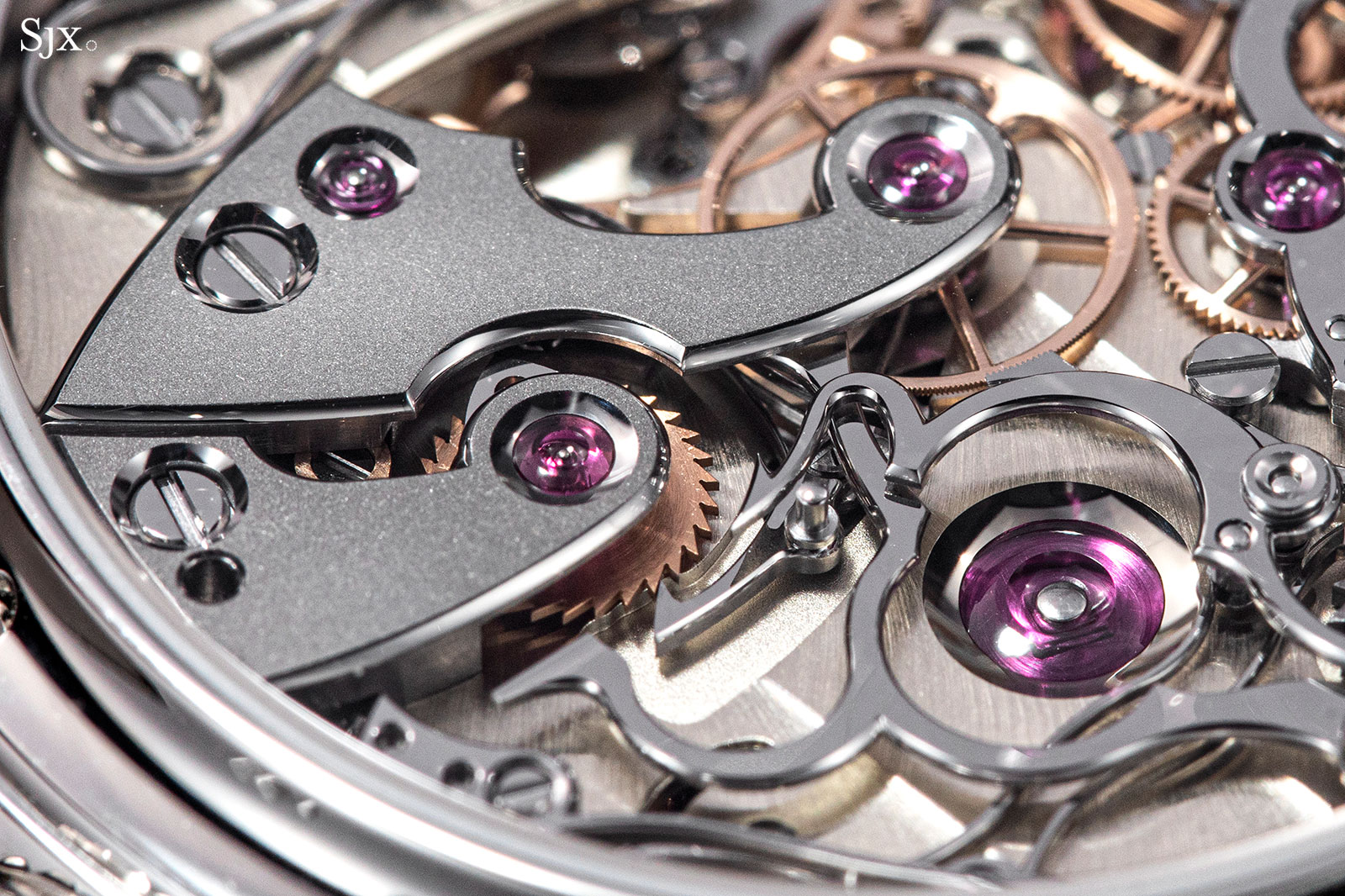
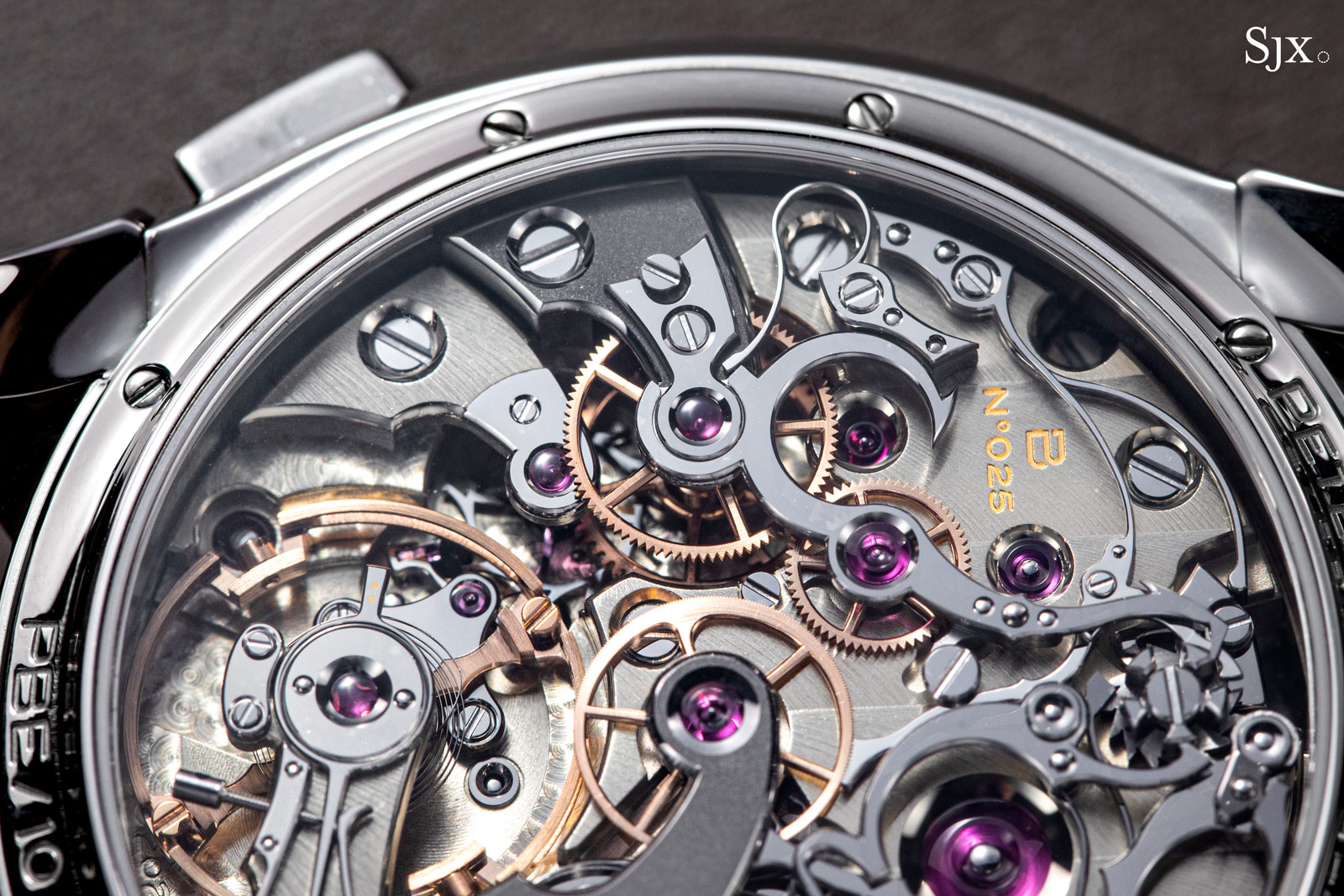
The appeal of the movement remains even when up close. The decoration is extensive, comprehensive, and top quality. The finer details of the 2941 movement are artisanal and a step above the finishing of the Lange Triple Split movement, comparable to Voutilainen in fact.
The movement naturally has all of the requisite decoration, including striping on the bridges and lots of black-polished steel parts. But it also includes an unusual decorative choice in the form of frosted chronograph bridges. Despite being unconventional, these frosted bridges enhance the classical appearance of the movement while adding contrast in both colour and texture.
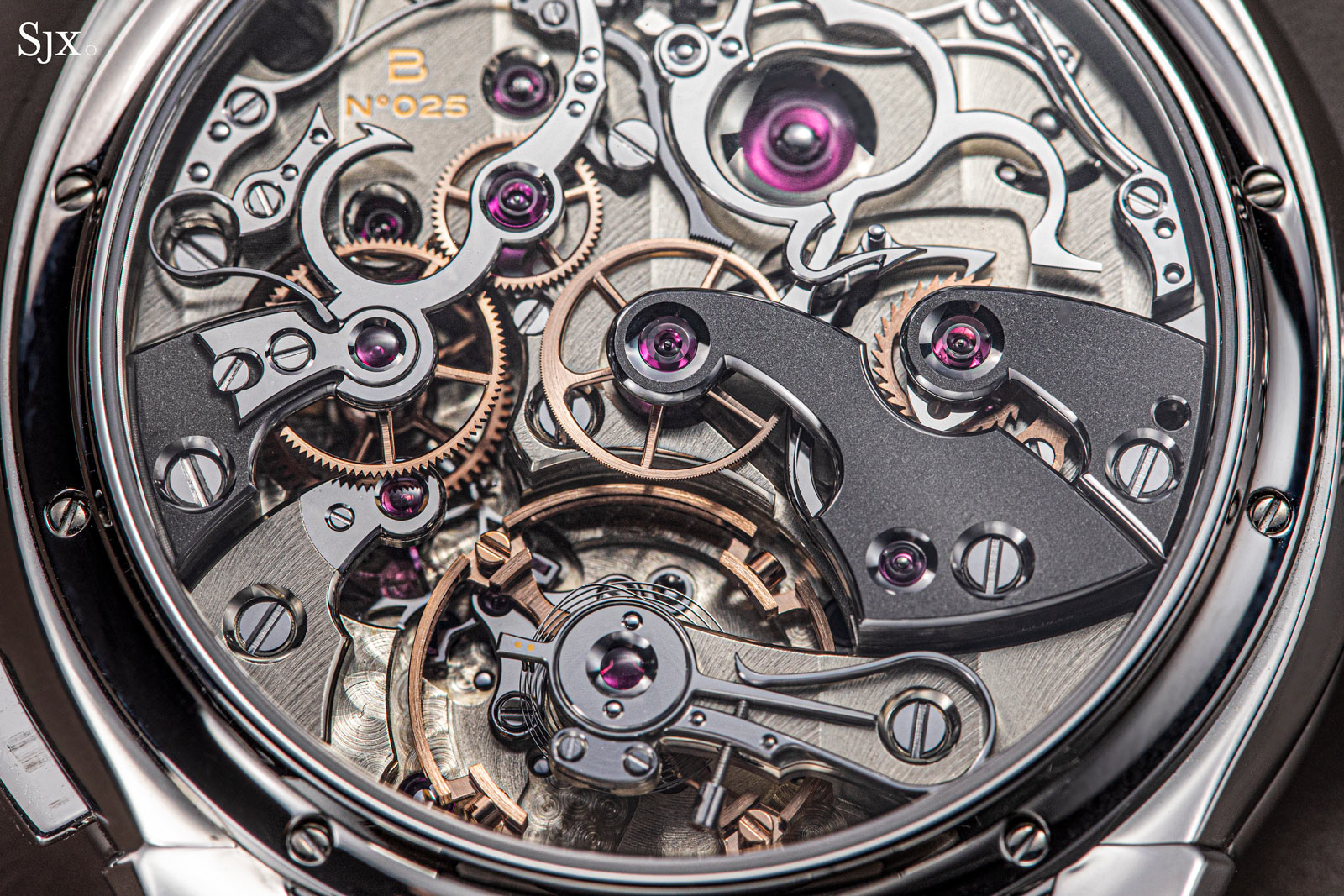
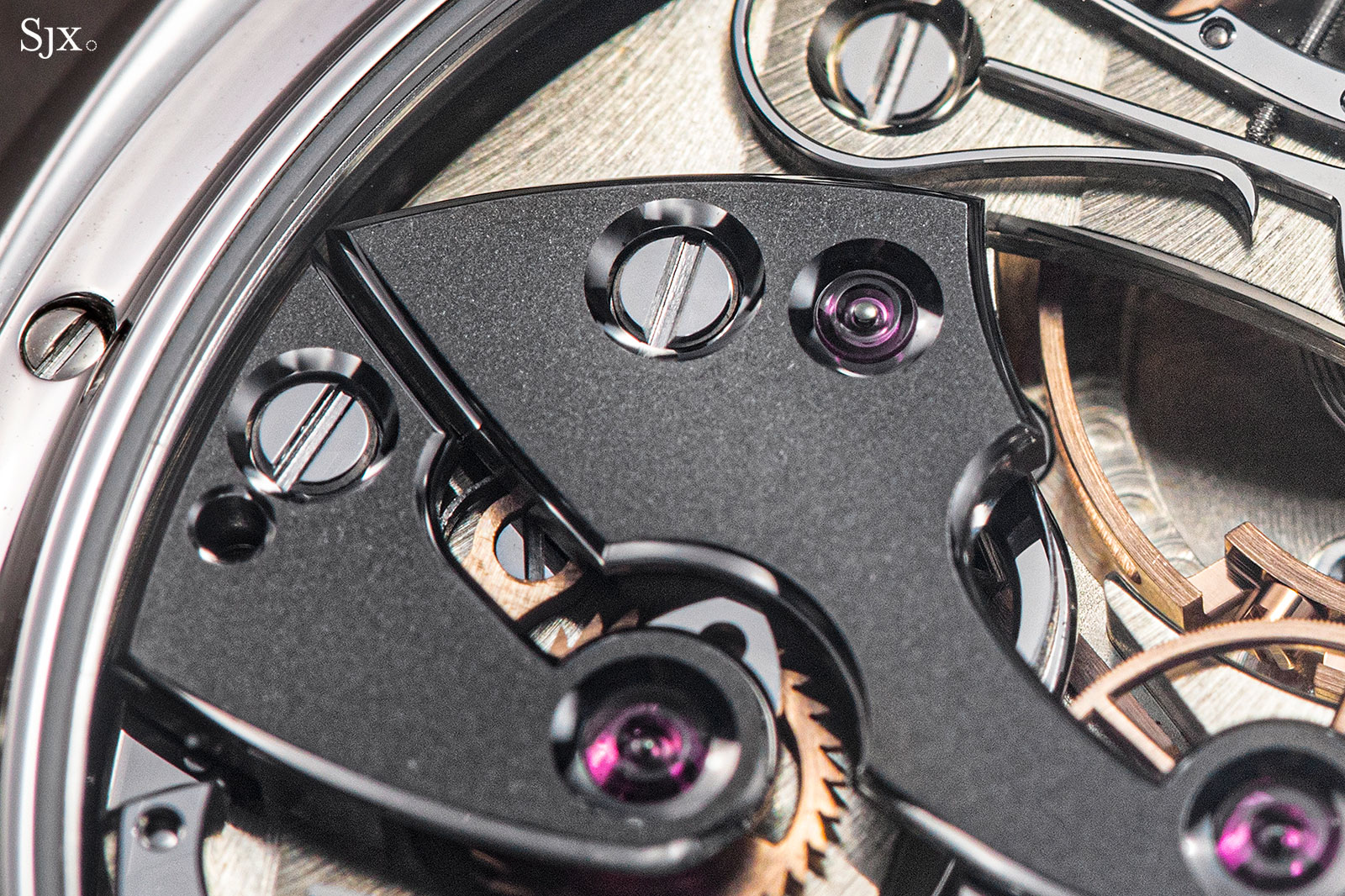
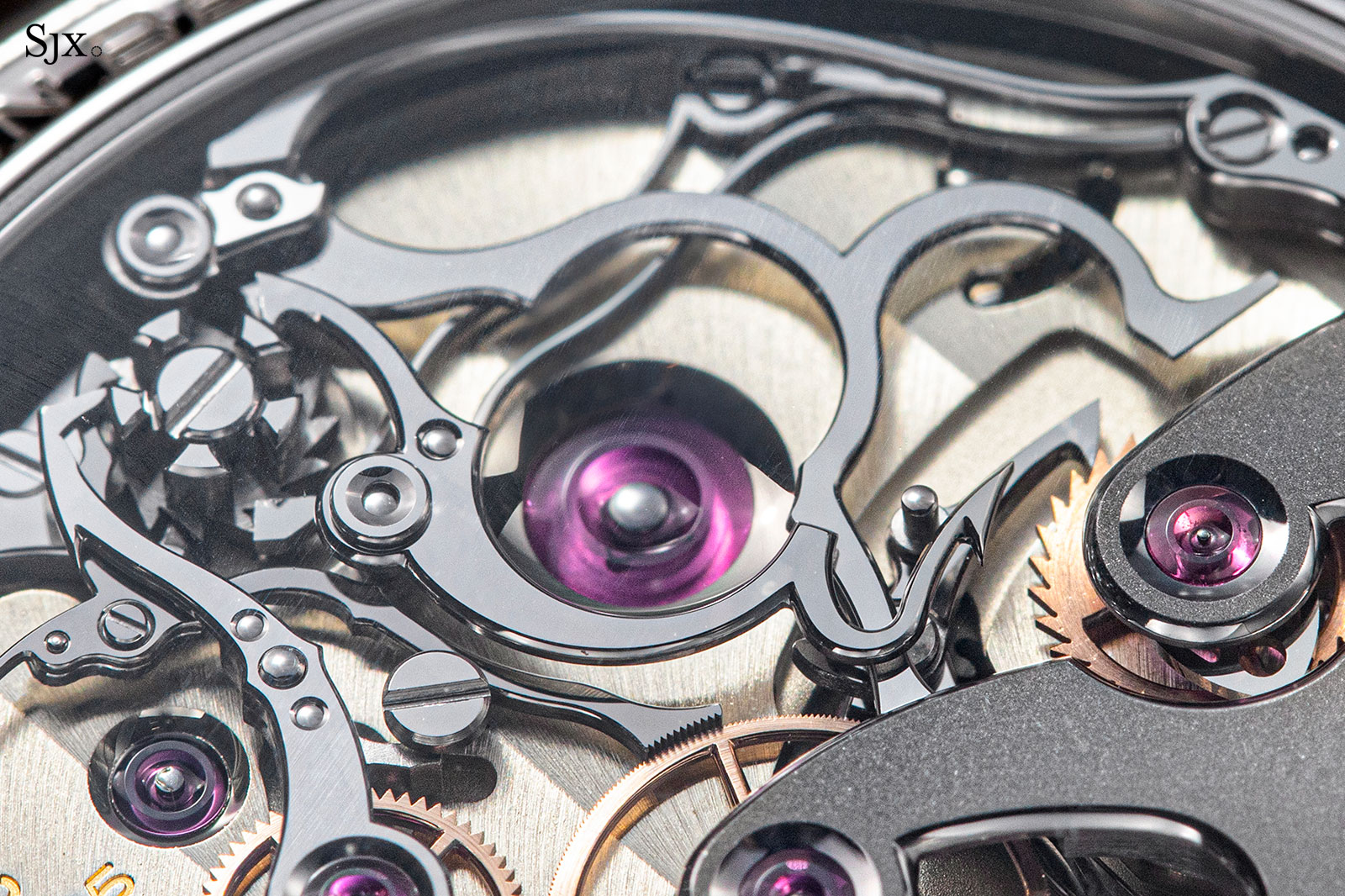
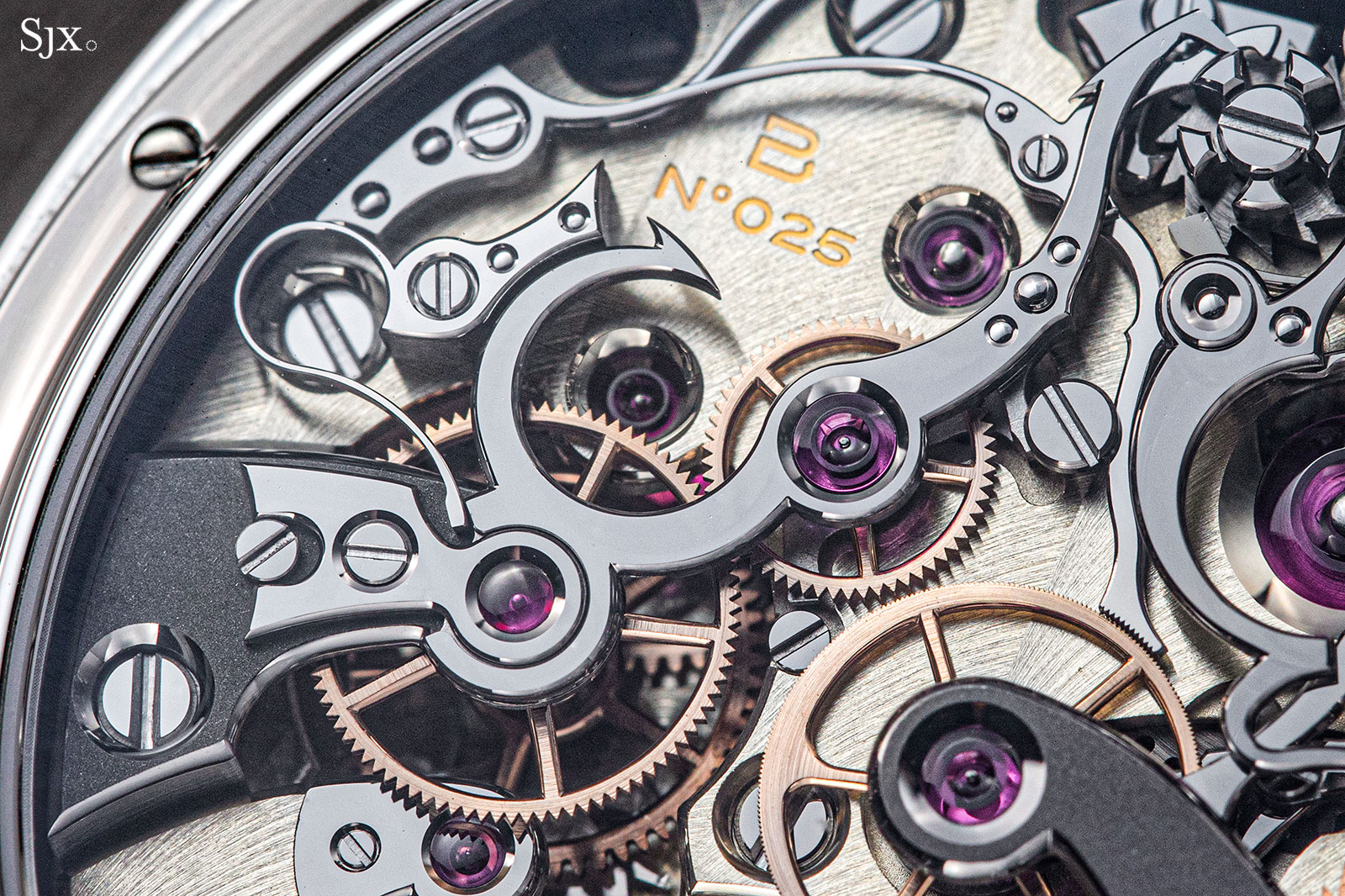
On closer examination, the similarity of the cal. 202’s base with the cal. 171 of the 1967 is clear, most obviously in the position of the extra-large jewel for the mainspring pivot, winding click, balance, and escape wheel. However, the gear train was rearranged in the cal. 202 in order to accommodate the split-seconds mechanism under the dial.
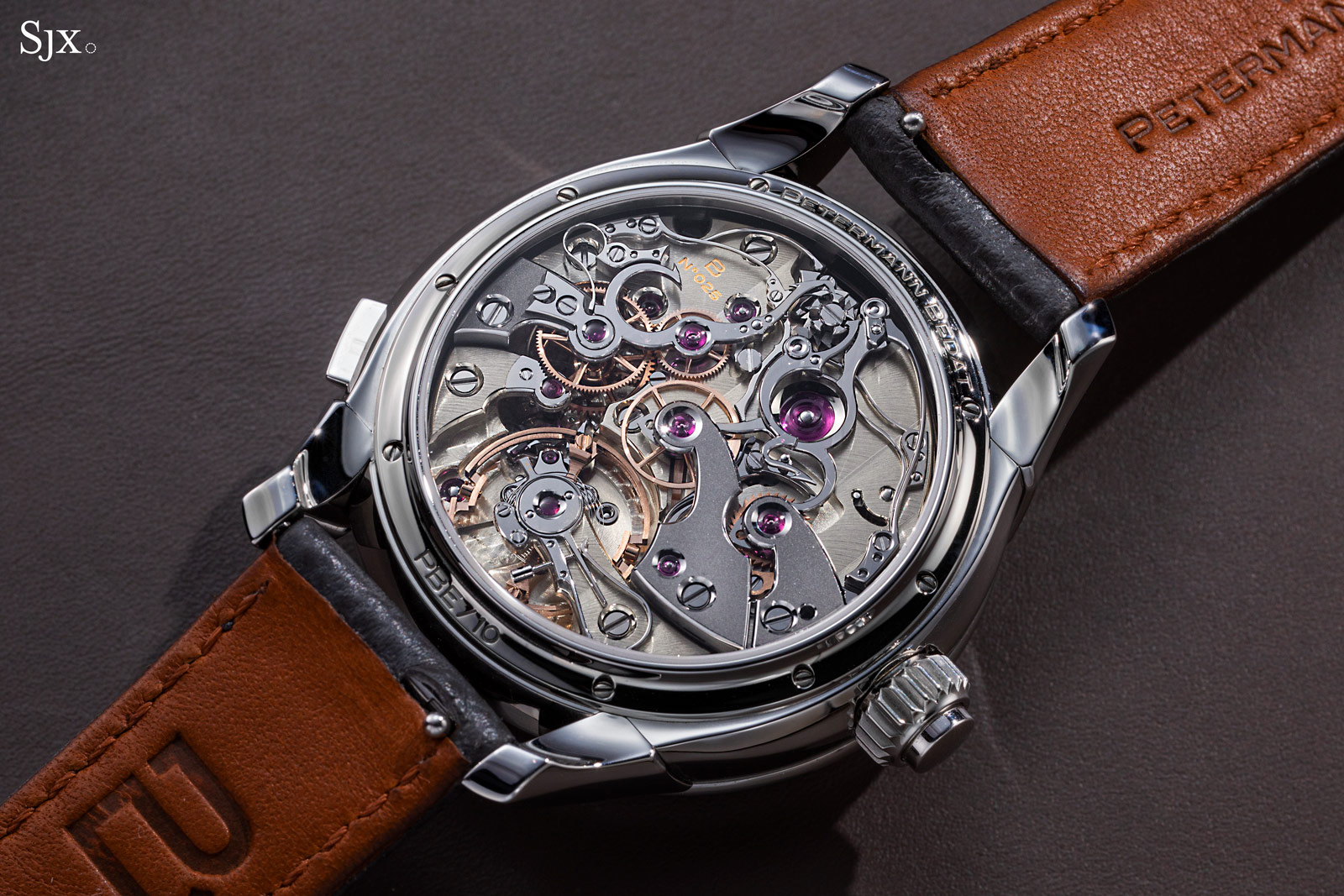
The cal. 202 of the 2941
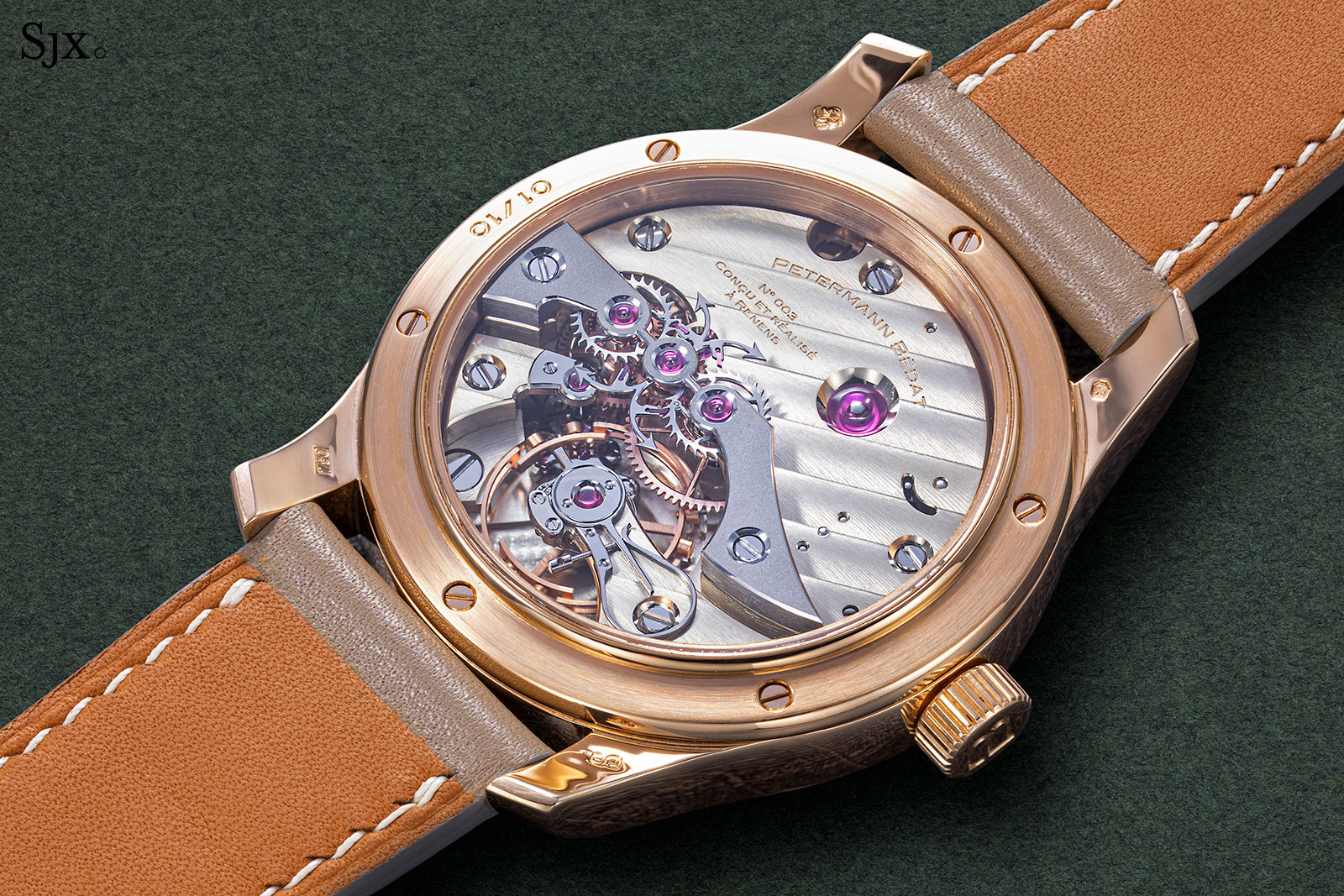
The cal. 171 in the 1967
The shared base can perhaps be forgiven, since the Valjoux 13”’ that inspired it is a highly regarded movement found in many valuable vintage watches. But the choice to install the split-seconds mechanism on the front is harder to understand, especially considering the elaborate decoration and high price.
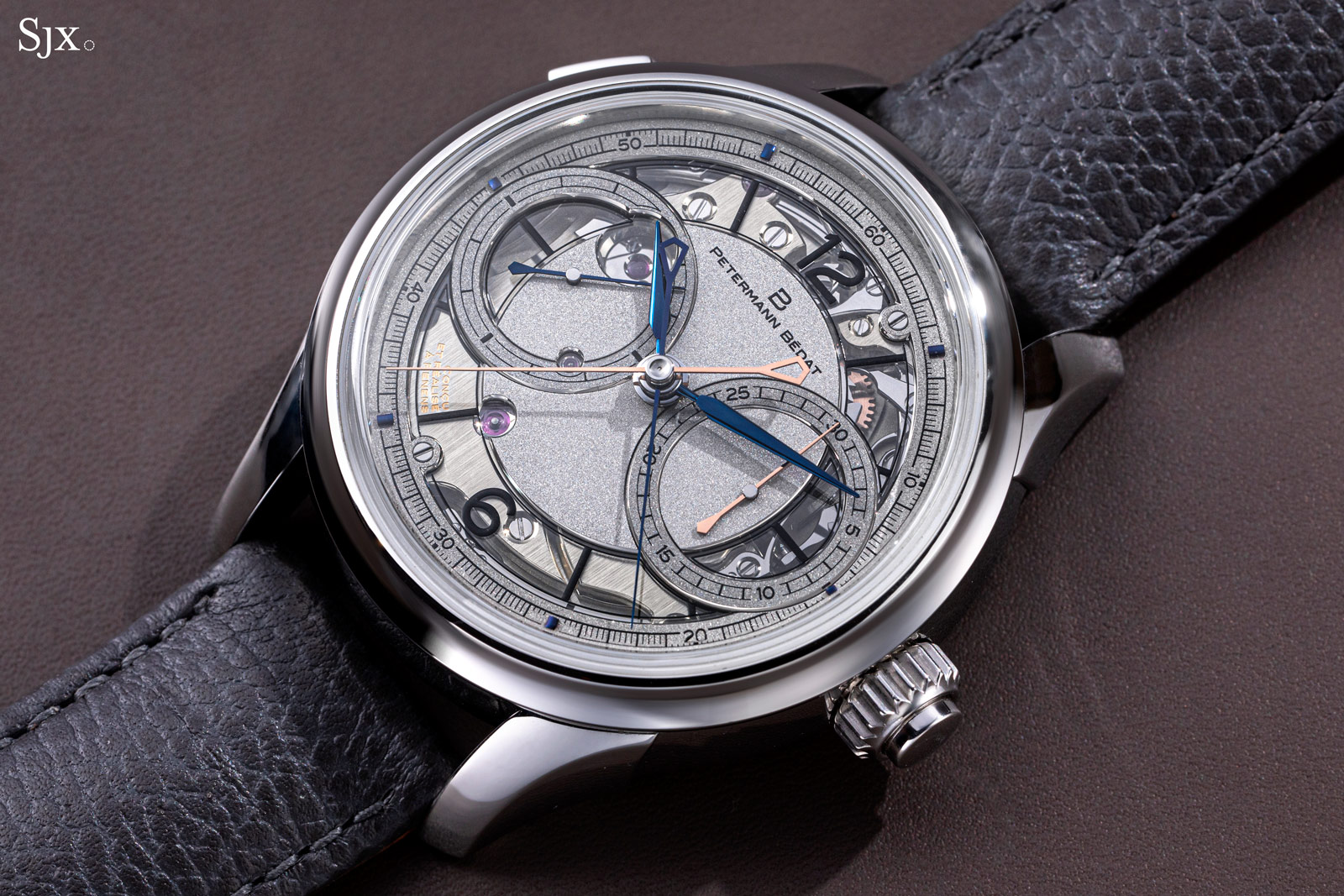
Adding a split-seconds on the back is possible and has been done before: the Patek Philippe ref. 1436 split-seconds chronograph that was in production from 1938 to 1971 was powered by the cal. 13-130 with an added rattrapante mechanism. Its movement has the same Valjoux 13”’ base found in the cal. 202 of the 2941, indicating that positioning the split-seconds mechanism on the back is possible.
As an aside, installing the split-seconds mechanism on the back would not have required a rearrangement of the gear train in the base movement, which is the case in the Valjoux 13”’-based movement inside the vintage Patek Philippe ref. 1436 split-seconds chronograph.
As it is in the 2941, the split-seconds mechanism is partially visible thanks to the sapphire chapter ring on the dial. The column whee can be seen just under “12”, along with portions of the levers. The decoration of the components under the dial is clearly as good as those on the reverse, so it’s a pity they are not more visible.
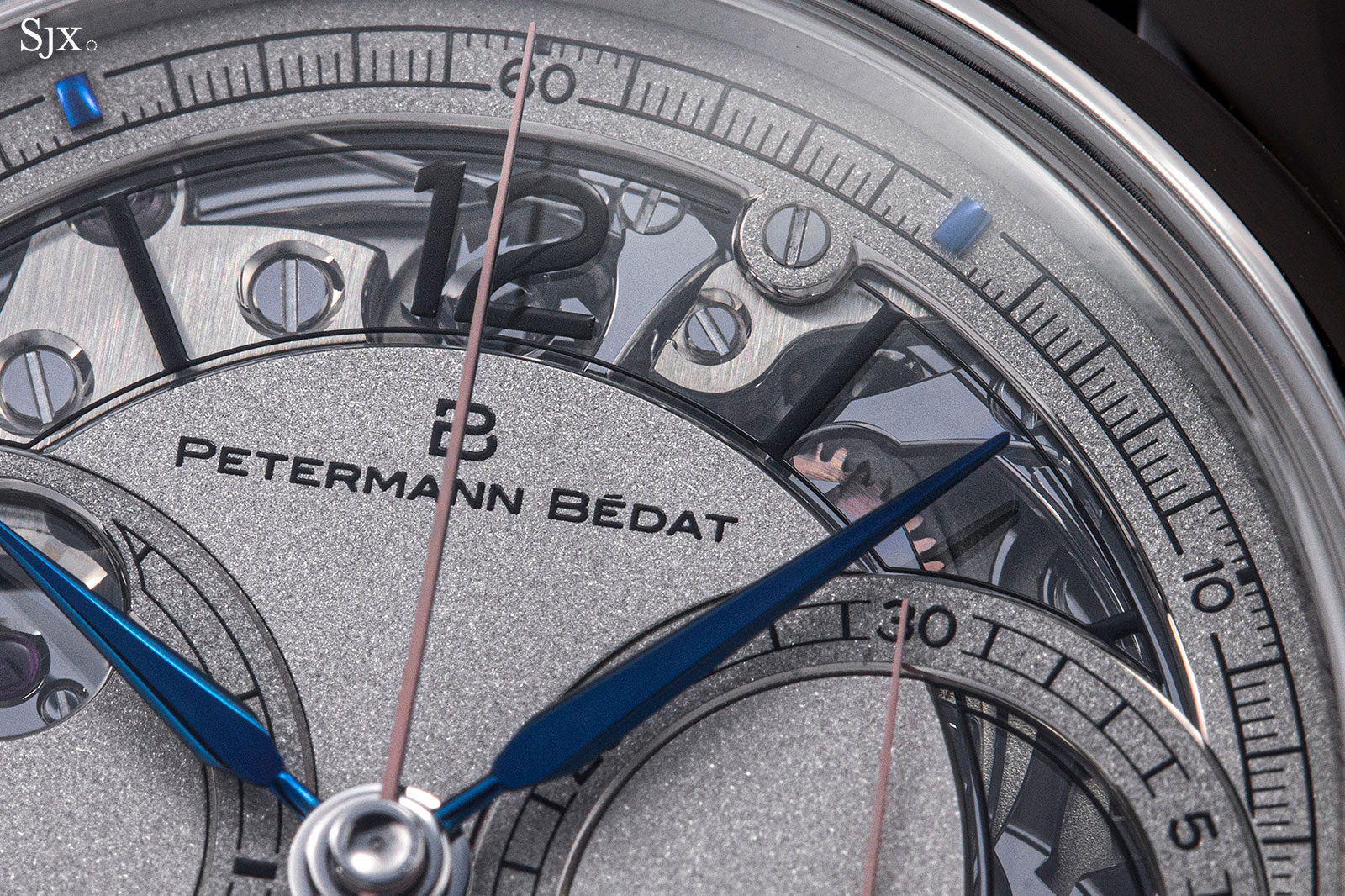
The column wheel is barely visible under “12”
The rest of the watch
The dial of the 2941 sticks to the formula established by the 1967, featuring the same “sector” style design that’s been modernised with a clear sapphire chapter ring and contemporary finishing. It’s a handsome look that successfully blends vintage and modern elements.
The dial layout is balanced, although the registers are slightly larger than ideal. Each register extends from the hands to the edge of the dial, which is typical of modern chronograph dials, but the vintage-inspired basis of the dial would have been better served with smaller counters.
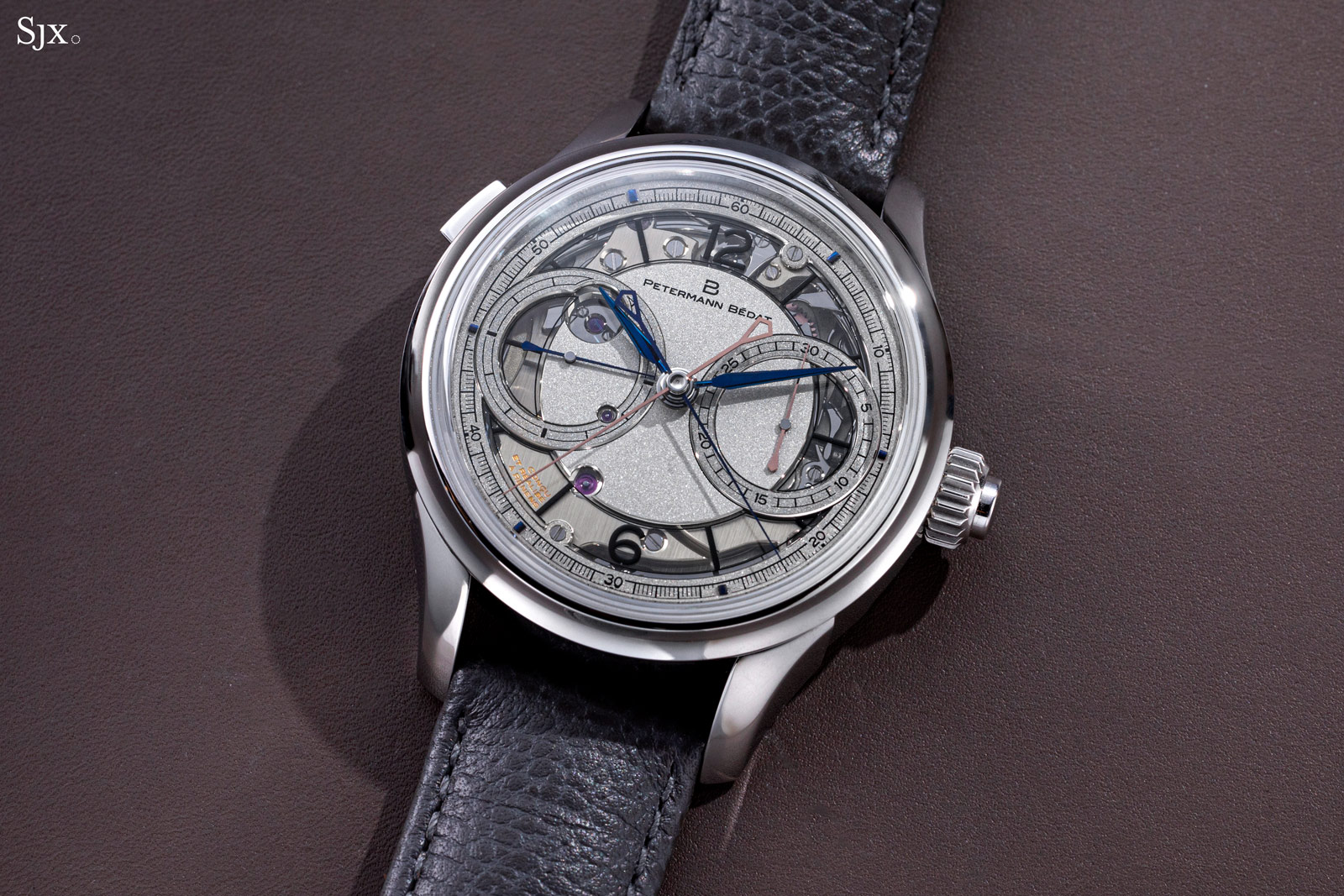
Like the movement, the dial is finished well. In fact, it is executed even more fancily than the movement in terms of materials. Each of the dial plates – two registers, outer track, and central disc – are made of frosted platinum. The platinum plates in turn sit on a clear sapphire disc that reveals part of the movement below.
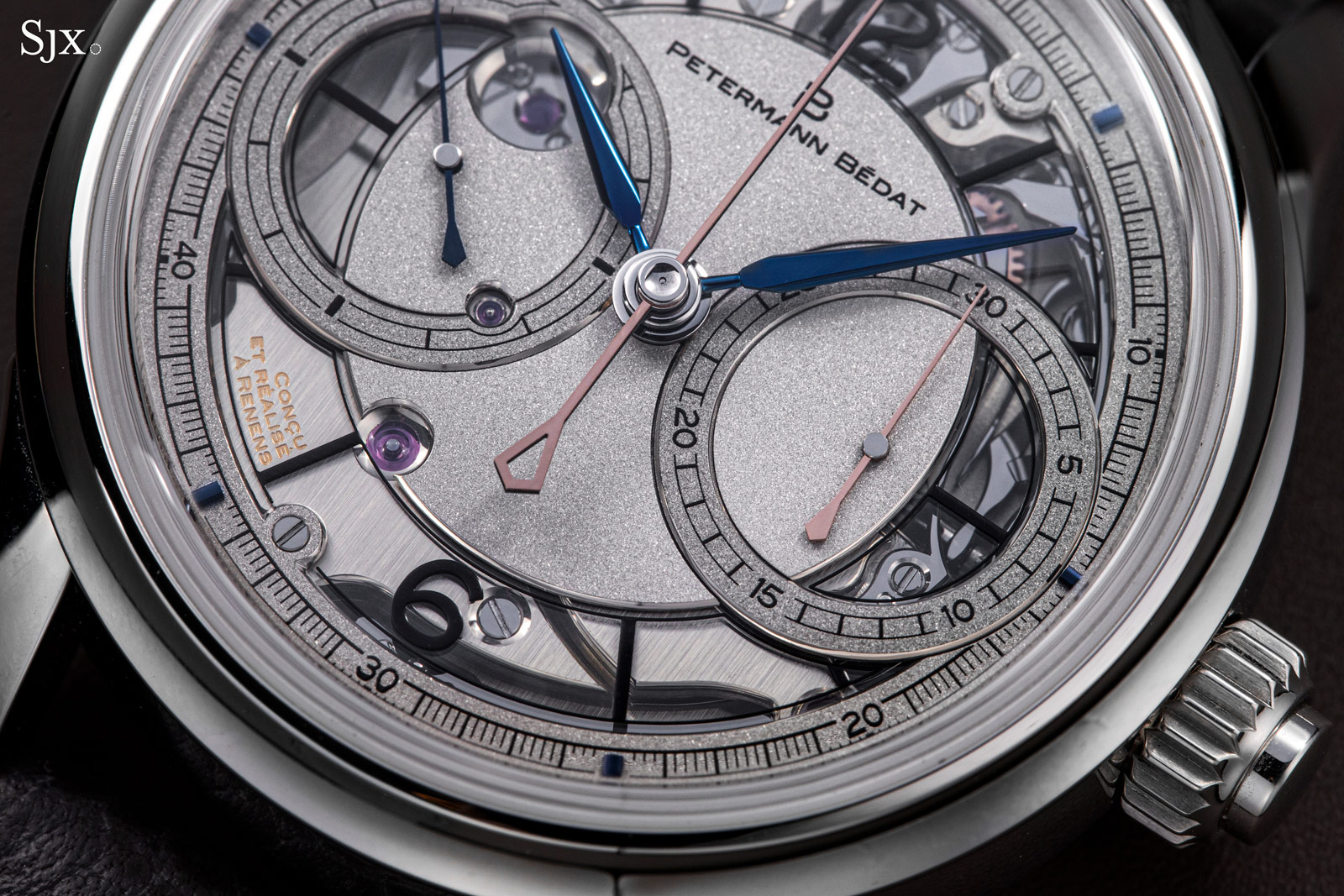
The plates are further decorated like movement components, so the frosted top surfaces are complemented by polished bevels along the edges. Similarly, the hours and minute hands are rounded and polished by hand.
The highly elaborate nature of the dial means it is definitely one of the most expensive aspects of the watch. Outstanding as it is, the dial feels a little unnecessary, particularly since it was made by Comblémine, a dial maker owned by Voutilainen that does artisanal work on an industrial scale, so it does not reflect the skill of Petermann Bédat. I would have preferred a simpler, high-quality dial and a lower price tag.
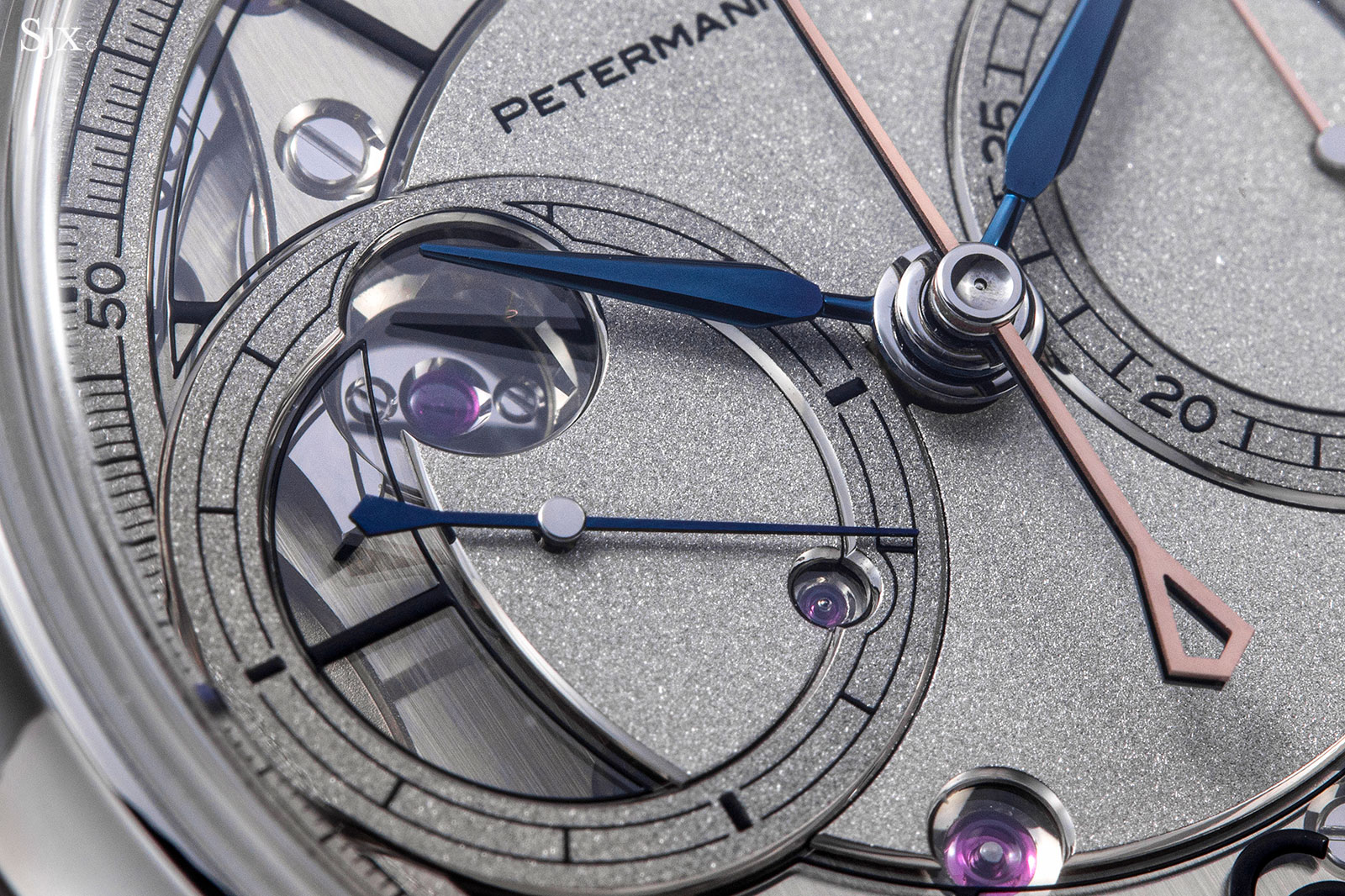
The case of the 2941 is a subtle but successful design. Most notably, the case is not particularly large at 38.6 mm in diameter, yet it doesn’t feel chunky, which is credit to the case design. It manages to camouflage the substantial thickness of the watch – the case is 13.7 mm tall – with a concave bezel and slightly curved profile featuring arched lugs that flare outwards slightly.
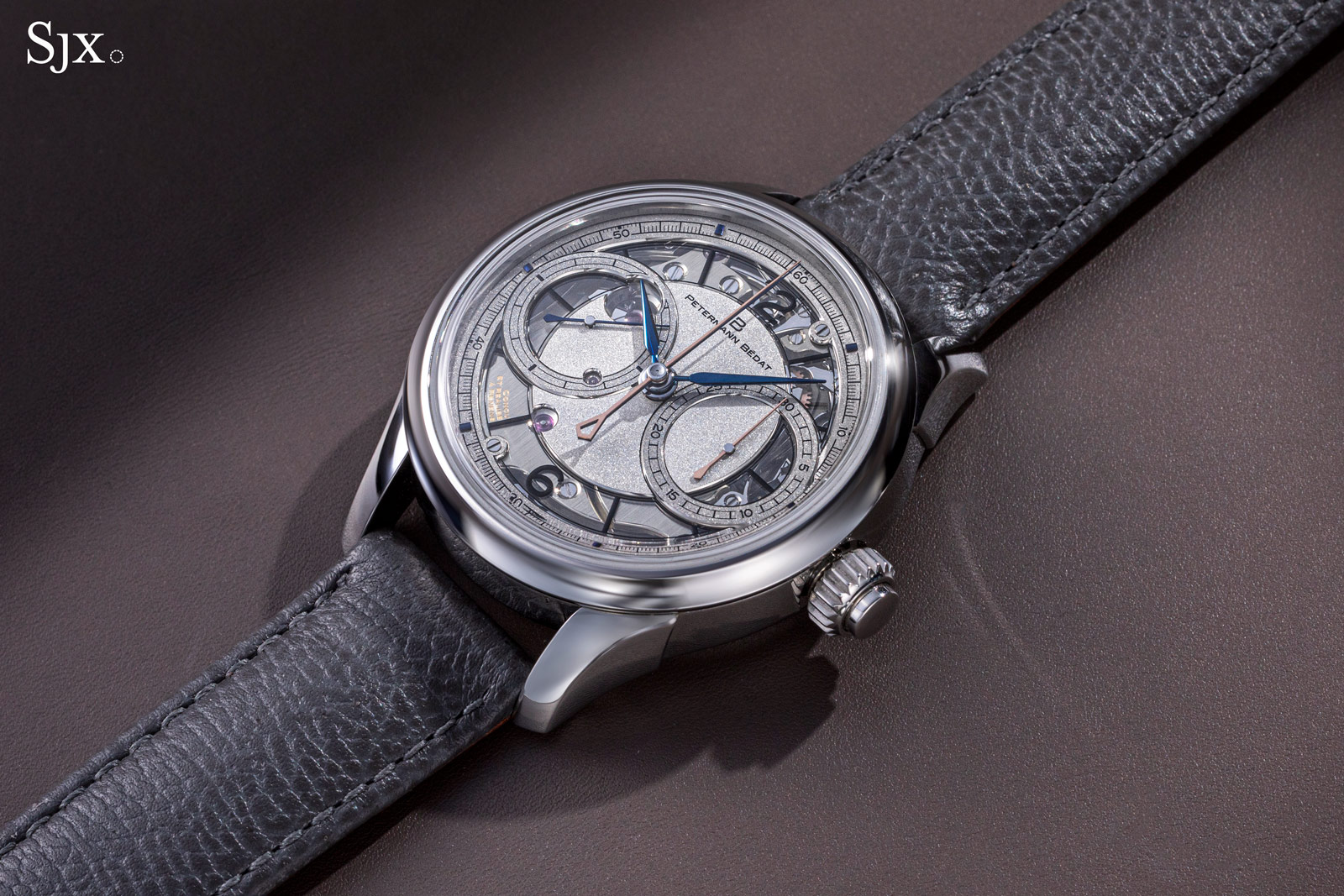
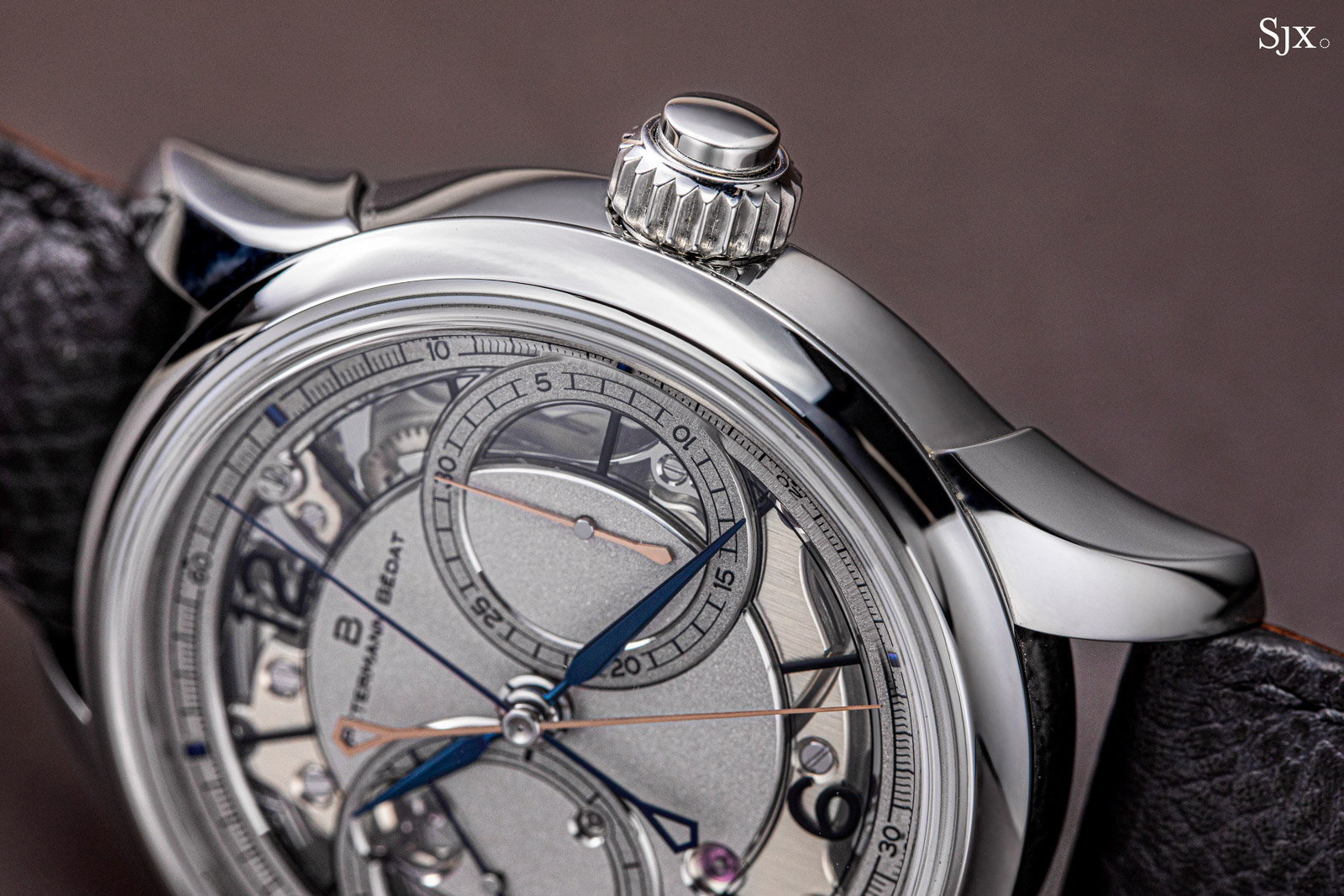
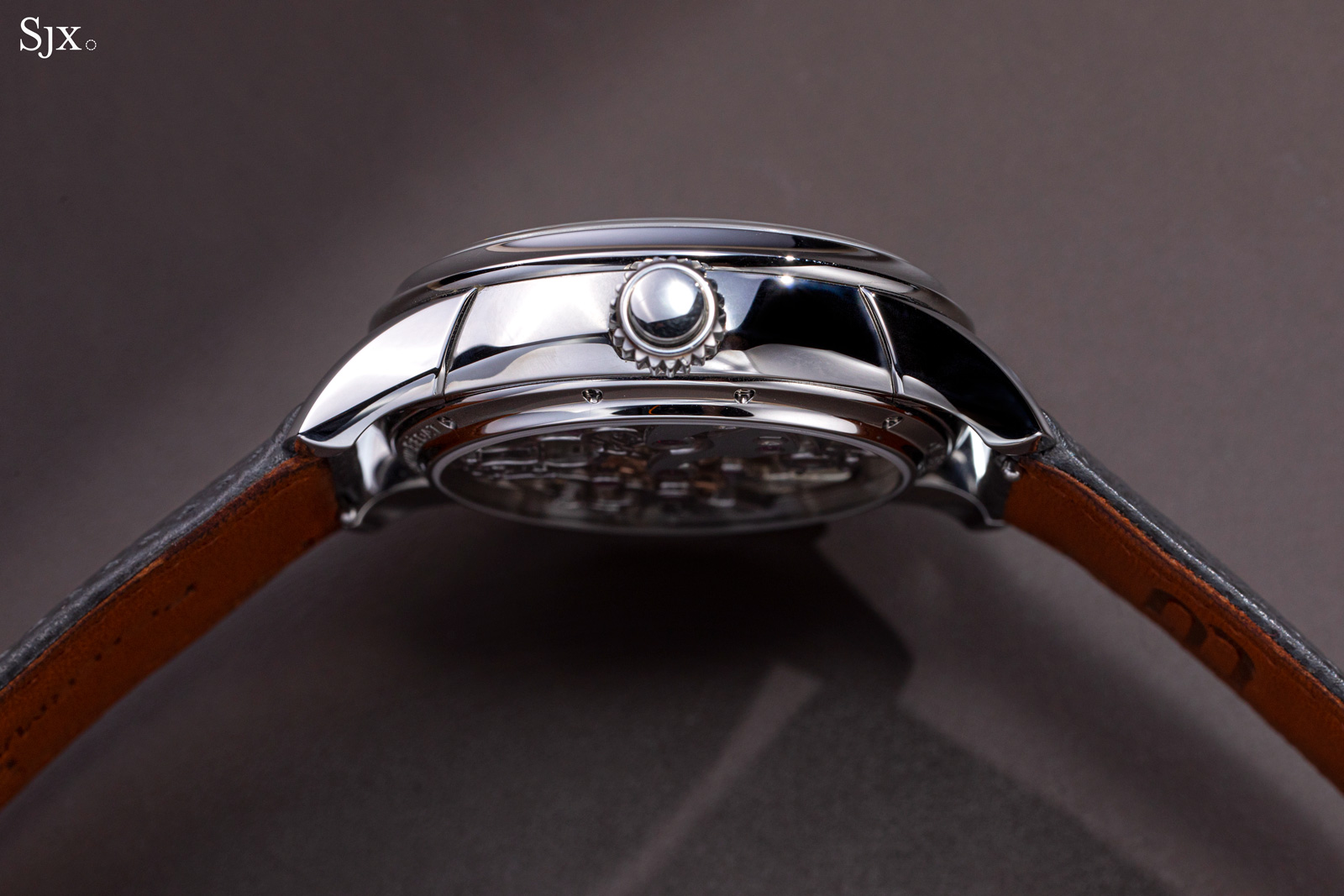
Concluding thoughts
The 2941 brings with it high expectations because of the high price tag. And it meets many of the expectations and excels in many ways – most notably movement decoration and aesthetics – but still falls short in a few crucial areas, including the split-seconds set up.
Seen in the context of the brand’s scale and approach, the strengths and weaknesses of the 2941 are understandable, particularly the constraints in development and cost of components. However, they prevent the watch from being great, even though it is very good.
Key facts and price
Petermann Bédat Reference 2941 Monopusher Split-Seconds Chronograph
Ref. 2941 (platinum)
Diameter: 38.6 mm
Height: 13.7 mm
Material: Platinum
Crystal: Sapphire
Water resistance: Unspecified
Movement: Cal. 202
Features: Hours, minutes, monopusher chronograph, split seconds
Frequency: 18,000 beats per hour (2.5 Hz)
Winding: Manual
Power reserve: 42 hours
Strap: Alligator leather strap
Limited edition: 10 pieces
Availability: Direct from Petermann Bedat or authorised retailers
Price: CHF243,000 excluding VAT
For more, visit Petermann-bedat.ch.
Back to top.

